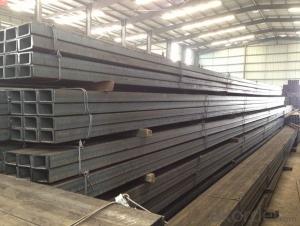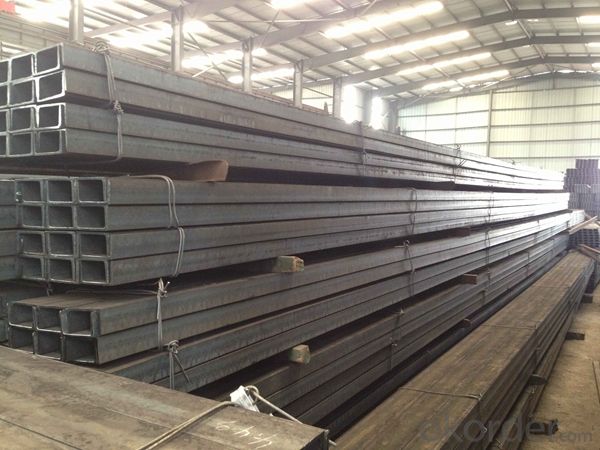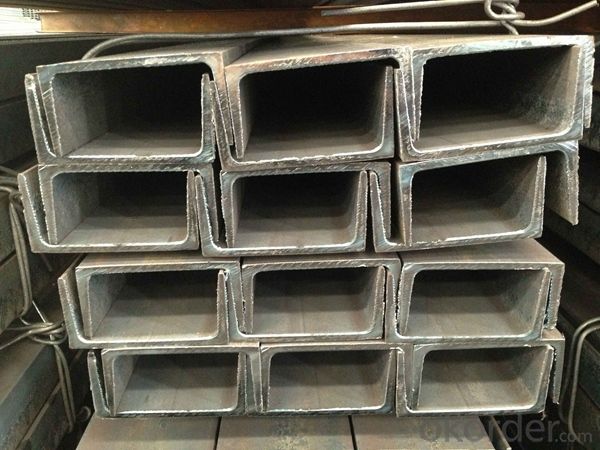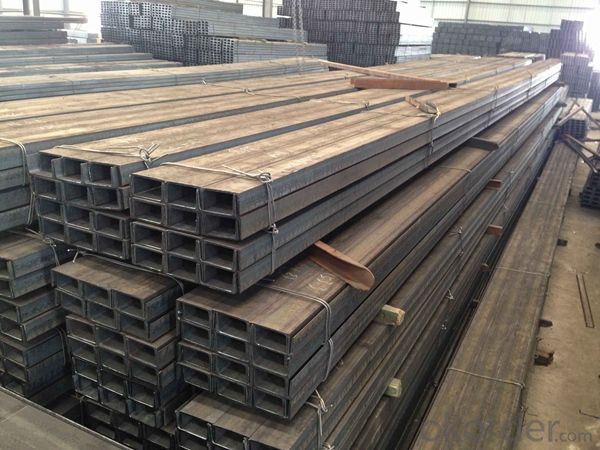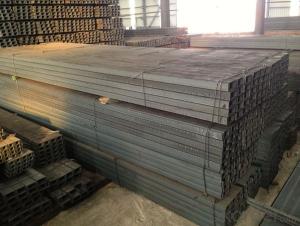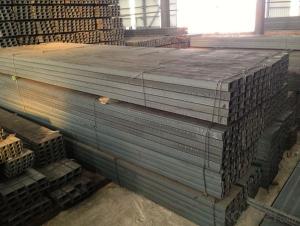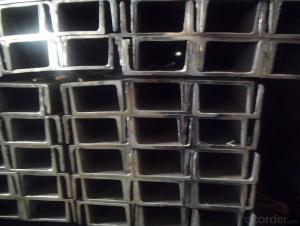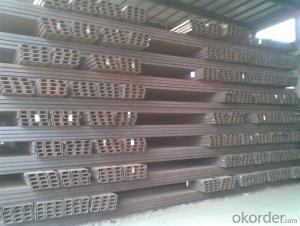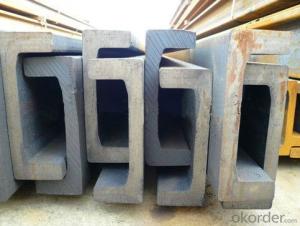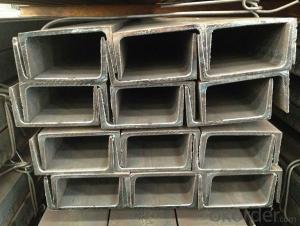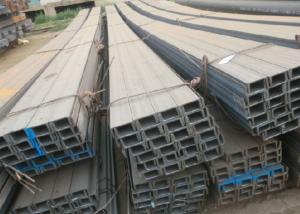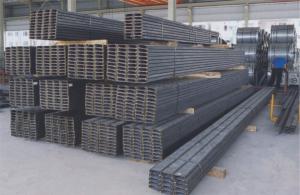Hot Rolled MS Mild GB Steel U Channels for Strcutures
- Loading Port:
- Shanghai
- Payment Terms:
- TT OR LC
- Min Order Qty:
- 25 m.t.
- Supply Capability:
- 200000 m.t./month
OKorder Service Pledge
OKorder Financial Service
You Might Also Like
Product Description:
OKorder is offering Hot Rolled MS Mild GB Steel U Channels for Strcutures at great prices with worldwide shipping. Our supplier is a world-class manufacturer of steel, with our products utilized the world over. OKorder annually supplies products to European, North American and Asian markets. We provide quotations within 24 hours of receiving an inquiry and guarantee competitive prices.
Product Applications:
Hot Rolled MS Mild GB Steel U Channels for Strcutures are ideal for structural applications and general fabricating. The steel u channel can be applied to construction of warehouses, workshops, sport stadiums and car parks etc. In details, the steel u channel belongs to carbon structural steel which is applied to in the field of construction and machinery. The steel u channel is usually used for arch-itechtural structure, and they could be welded in order to support or hang a vari-ety of facilities. They are also usually used in combination with I beam. Generally,the steel u channel must possess perfect welding property, riveting property and mechanical property and so on.
Product Advantages:
Hot Rolled MS Mild JIS Steel U Channels for Strcutures are durable, strong, and resists corrosion.
Main Product Features:
· Premium quality
· Prompt delivery & seaworthy packing (7-10 days after receiving deposit)
· Corrosion resistance
· Can be recycled and reused
· Mill test certification
· Professional Service
· Competitive pricing
Product Specifications:
1.We supply high quality MS Channel at reasonable price, including Chinese standard, Japanese standard and so on.
Standard | GB/JIS |
Material Grade | Q235,SS400 |
Technique: | Hot Rolled |
Sizes as per chinese standard: | 50*37*4.5mm - 300*89*11.5mm |
Sizes as per japanese standard: | 50*25*3mm – 200*80*7.5mm |
Length: | 6meter, 9meter, 12meter |
Note: 1.we are also competent to provide our customers other MS Channel based on other sizes according to customer’s requirements.
2. The length of our ms channel could be cut into other meters as per customer’s requirements. For example, the channel in 6meters could be cut into 5.8meters in order to be fit in the 20ft container.
2. The detailed sections of MS Channel as per GB standard.are shown in the table-1:
GB U CHANNEL | Standard | Sectional | Dimension |
| Mass: |
(mm) | (mm) | (mm) | (mm) | ||
50X37 | 50 | 37 | 4.50 | 7.0 | 5.438 |
63X40 | 63 | 40 | 4.80 | 7.5 | 6.634 |
80x43 | 80 | 43 | 5.00 | 8.0 | 8.045 |
100x48 | 100 | 48 | 5.30 | 8.5 | 10.007 |
120x53 | 120 | 53 | 5.50 | 9.0 | 12.059 |
140x58 | 140 | 58 | 6.00 | 9.5 | 14.535 |
140x60 | 140 | 60 | 8.00 | 9.5 | 16.733 |
160x63 | 160 | 63 | 6.50 | 10.0 | 17.240 |
160x65 | 160 | 65 | 8.50 | 10.0 | 19.752 |
180x68 | 180 | 68 | 7.00 | 10.5 | 20.174 |
180x70 | 180 | 70 | 9.00 | 10.5 | 23.000 |
200x73 | 200 | 73 | 7.00 | 11.0 | 22.637 |
200x75 | 200 | 75 | 9.00 | 11.0 | 25.777 |
220x77 | 220 | 77 | 7.00 | 11.5 | 24.999 |
220x79 | 220 | 79 | 9.00 | 11.5 | 28.453 |
250x78 | 250 | 78 | 7.00 | 12.0 | 27.410 |
250x80 | 250 | 80 | 9.00 | 12.0 | 31.335 |
250x82 | 250 | 82 | 11.00 | 12.0 | 35.260 |
280x82 | 280 | 82 | 7.50 | 12.5 | 31.427 |
280x84 | 280 | 84 | 9.50 | 12.5 | 35.823 |
280x86 | 280 | 86 | 11.50 | 12.5 | 40.219 |
300x85 | 300 | 85 | 7.50 | 13.5 | 34.463 |
300x87 | 300 | 87 | 9.50 | 13.5 | 39.173 |
300x89 | 300 | 89 | 11.50 | 13.5 | 43.883 |
Table-1
3. The chemical composition of HR Channel Steel according to Q235B is shown in Table-2.
Alloy No | Grade | Element(%) | ||||
C | Mn | S | P | Si | ||
Q235 | B | 0.12-0.20 | 0.3-0.7 | ≦0.045 | ≦0.045 | ≦0.3 |
Table-2
Note: we are able to present our customers relevant SGS test report for chemical composition of HR Channel Steel.
4. The mechanical property of HR Channel Steel according to Q235B is shown in Table-3-1 and Table-3-2
Alloy No | Grade | Yielding Strength Point(Mpa) | |||
Thickness(mm) | |||||
≦16 | >16-40 | >40-60 | >60-100 | ||
≧ | |||||
Q235 | B | 235 | 225 | 215 | 205 |
Table-3-1
Alloy No | Grade | Tensile Strength(Mpa) | Elongation After Fracture(%) | |||
Thickness(mm) | ||||||
≦16 | >16-40 | >40-60 | >60-100 | |||
≧ | ||||||
G235 | B | 375-500 | 26 | 25 | 24 | 23 |
Table-3-2
Note: we are able to present our customers relevant SGS test report for mechanical property of MS Channel as customer’s request.
FAQ:
Q1: Why buy Materials & Equipment from OKorder.com?
A1: All products offered byOKorder.com are carefully selected from China's most reliable manufacturing enterprises. Through its ISO certifications, OKorder.com adheres to the highest standards and a commitment to supply chain safety and customer satisfaction.
Q2: How do we guarantee the quality of our products?
A2: We have established an advanced quality management system which conducts strict quality tests at every step, from raw materials to the final product. At the same time, we provide extensive follow-up service assurances as required.
Q3: How soon can we receive the product after purchase?
A3: Within three days of placing an order, we will begin production. The specific shipping date is dependent upon international and government factors, but is typically 7 to 10 workdays.
Q4: What makes stainless steel stainless?
A4: Stainless steel must contain at least 10.5 % chromium. It is this element that reacts with the oxygen in the air to form a complex chrome-oxide surface layer that is invisible but strong enough to prevent further oxygen from "staining" (rusting) the surface. Higher levels of chromium and the addition of other alloying elements such as nickel and molybdenum enhance this surface layer and improve the corrosion resistance of the stainless material.
Q5: Can stainless steel rust?
A5: Stainless does not "rust" as you think of regular steel rusting with a red oxide on the surface that flakes off. If you see red rust it is probably due to some iron particles that have contaminated the surface of the stainless steel and it is these iron particles that are rusting. Look at the source of the rusting and see if you can remove it from the surface.
Images:
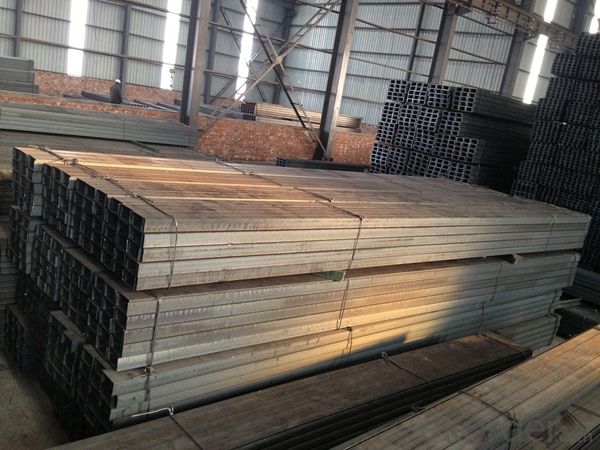
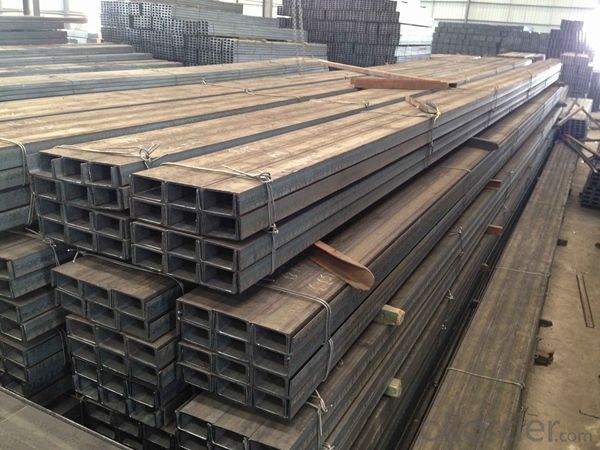
- Q: Are steel channels suitable for use in corrosive environments?
- No, steel channels are not suitable for use in corrosive environments as they are prone to rust and corrosion.
- Q: How do steel channels contribute to earthquake resistance in buildings?
- Steel channels contribute to earthquake resistance in buildings in several ways. Firstly, steel channels are commonly used as structural members in building frames. They provide strength and rigidity to the overall structure, which helps to resist the lateral forces generated during an earthquake. These lateral forces, also known as seismic forces, can cause buildings to sway and deform. By using steel channels, the building's frame becomes more resistant to these forces, reducing the risk of collapse. Secondly, steel channels can be strategically placed in key areas of the building to enhance its seismic performance. For example, they can be used as braces or shear walls to provide additional support and stability. Bracing systems made of steel channels help to distribute the seismic forces throughout the structure, preventing concentrated stress points and improving overall structural integrity. Moreover, steel channels can be integrated into the foundation of the building to enhance its resilience against ground motion during an earthquake. By connecting the foundation to the superstructure using steel channels, the building's ability to absorb and dissipate seismic energy is improved. This helps to minimize the transfer of forces to the building, reducing the potential for damage. Additionally, steel channels offer ductility, which is crucial for earthquake resistance. Ductility refers to the ability of a material to deform without breaking. During an earthquake, buildings experience significant stress and deformation. Steel channels have the capacity to absorb this energy and deform without losing their structural integrity. This ductile behavior prevents sudden failure and allows the building to undergo controlled and controlled deformation, thereby enhancing its overall seismic performance. In conclusion, steel channels play a vital role in enhancing earthquake resistance in buildings. Their strength, rigidity, strategic placement, integration into the foundation, and ductility all contribute to improving the structural integrity and resilience of a building during seismic events. By incorporating steel channels into the design and construction of buildings, the risk of collapse and damage due to earthquakes can be significantly reduced.
- Q: Can steel channels be used in water treatment plants?
- Yes, steel channels can be used in water treatment plants. Steel channels are commonly used in water treatment plants for various applications such as supporting infrastructure, conveying and directing water flow, and providing structural stability. The corrosion resistance and durability of steel make it a suitable material for handling water treatment processes effectively.
- Q: What are the different types of steel channel supports?
- There are several different types of steel channel supports that are commonly used in construction and engineering projects. These supports are designed to provide structural stability and support for various applications. Some of the different types of steel channel supports include: 1. C-Channel Supports: These supports are shaped like a letter "C" and provide excellent strength and rigidity. They are commonly used in industrial applications such as supporting heavy equipment and machinery. 2. U-Channel Supports: Similar to C-channel supports, U-channel supports are shaped like a letter "U". They are versatile and can be used in a variety of applications, including framing and bracing structures. 3. Back-to-Back Channel Supports: These supports consist of two parallel channels that are welded back-to-back. They offer increased strength and stability and are commonly used in applications that require additional load-bearing capacity. 4. Slotted Channel Supports: Slotted channel supports feature slots along the length of the channel, allowing for easy adjustment and flexibility. They are often used in applications where the position of the support needs to be adjustable. 5. Strut Channel Supports: Also known as strut or framing channel supports, these are designed with specially shaped channels that allow for easy attachment of fittings and accessories. They are commonly used in electrical and mechanical installations. 6. Adjustable Channel Supports: These supports feature telescoping or adjustable sections that allow for height and width adjustment. They are commonly used in applications where the support needs to be adaptable to changing requirements. 7. Stainless Steel Channel Supports: Stainless steel channel supports are made from corrosion-resistant stainless steel, making them ideal for applications in harsh or corrosive environments. These are just a few examples of the different types of steel channel supports available. Each type offers unique features and benefits, allowing for a wide range of applications in various industries. The choice of support will depend on the specific requirements of the project and the load-bearing capacity needed.
- Q: Can steel channels be used for creating support structures for communication towers?
- Yes, steel channels can be used for creating support structures for communication towers. Steel channels offer high strength and durability, making them suitable for carrying heavy loads and withstanding harsh weather conditions. Additionally, their versatile shape and design allow for easy installation and customization to meet the specific requirements of communication towers.
- Q: What are the different methods for protecting steel channels from corrosion?
- There are multiple techniques available to safeguard steel channels against corrosion. Here are a few of the most prevalent options: 1. Application of a protective coating: A highly effective approach involves applying a protective coating onto the surface of the steel channels. This can be accomplished using various methods such as paints, epoxy coatings, or galvanizing. Coatings act as a physical barrier, preventing direct contact and corrosion between the steel and the corrosive elements present in the environment. 2. Cathodic protection: Another method involves employing a sacrificial metal or an impressed current to shield the steel channels. By connecting sacrificial metals like zinc or magnesium to the channels, these metals, which are more reactive than steel, will corrode in place of the channels. Impressed current systems, on the other hand, utilize an external power source to generate an electric current that counteracts the corrosion process. 3. Use of corrosion inhibitors: Chemicals known as corrosion inhibitors can be applied to the steel channels to slow down or prevent corrosion. These inhibitors function by creating a protective layer on the channel's surface, hindering the reaction between the steel and the corrosive elements. 4. Considerations in design: Implementing proper design and construction practices can also contribute to the protection of steel channels from corrosion. This includes ensuring adequate drainage and ventilation to minimize moisture accumulation, avoiding the presence of crevices and areas prone to water buildup, and using materials that are less susceptible to corrosion in corrosive environments. 5. Regular maintenance: Routine inspections and maintenance activities, such as cleaning and removing any accumulated debris or dirt, play a crucial role in identifying and addressing potential corrosion issues at an early stage. This may involve reapplying coatings, repairing damaged areas, or replacing corroded sections of the steel channels. It is important to acknowledge that the selection of a protection method depends on factors such as the specific environment, the anticipated service life of the channels, and budgetary constraints. Seeking guidance from corrosion experts or professionals in the field can assist in determining the most suitable method for safeguarding steel channels from corrosion in a particular application.
- Q: How do steel channels contribute to the overall sustainability of a construction project?
- Steel channels contribute to the overall sustainability of a construction project in several ways. Firstly, steel channels are made from recycled materials. By using recycled steel, we are reducing the demand for virgin materials and minimizing the environmental impact associated with mining and processing raw materials. This reduces the depletion of natural resources and the energy required for production, making steel channels a more sustainable option. Secondly, steel channels have a long lifespan and require minimal maintenance. They are highly durable and resistant to corrosion, which means they can withstand harsh weather conditions and last for many years without the need for replacement or frequent repairs. This reduces the overall material consumption and waste generation, making the construction project more sustainable in the long run. Furthermore, steel channels are lightweight and easy to transport. This reduces the energy consumption and greenhouse gas emissions associated with transportation, as less fuel is required to move them from the manufacturing facility to the construction site. Additionally, their lightweight nature makes them easier to handle and install, reducing the need for heavy machinery and associated energy consumption during the construction process. Lastly, steel channels can be easily recycled at the end of their lifespan. Unlike other construction materials, steel can be melted down and reused multiple times without losing its properties. This not only reduces the amount of waste sent to landfills but also reduces the need for new steel production, further conserving natural resources and reducing environmental impact. In summary, steel channels contribute to the overall sustainability of a construction project by being made from recycled materials, having a long lifespan, being lightweight and easy to transport, and being recyclable at the end of their life. By incorporating steel channels into construction projects, we can reduce the environmental impact, conserve natural resources, and promote a more sustainable built environment.
- Q: What is the specific weight of 10# channel steel?
- Hot rolled light channel steel [(YB) 164-63]Height =100, leg width =46, waist thickness =4.5, average leg thickness =7.6, inner arc radius =7.0, leg end arc radius =3.0, sectional area (cm2) =10.9, theoretical weight (kg/m) =8.59
- Q: How are steel channels used in the construction of stadiums or arenas?
- Steel channels are commonly used in the construction of stadiums or arenas to provide structural support and reinforcement. They are often used to create the framework for seating areas, staircases, walkways, and other elevated structures. Steel channels help distribute the weight and load of the structure, ensuring its stability and durability. They also allow for flexibility in design, as they can be easily customized and assembled to fit the specific requirements of the project.
- Q: Which way is it better to weld the iron channel and galvanized steel channel in the house?
- Of course, galvanized well
Send your message to us
Hot Rolled MS Mild GB Steel U Channels for Strcutures
- Loading Port:
- Shanghai
- Payment Terms:
- TT OR LC
- Min Order Qty:
- 25 m.t.
- Supply Capability:
- 200000 m.t./month
OKorder Service Pledge
OKorder Financial Service
Similar products
Hot products
Hot Searches
Related keywords
